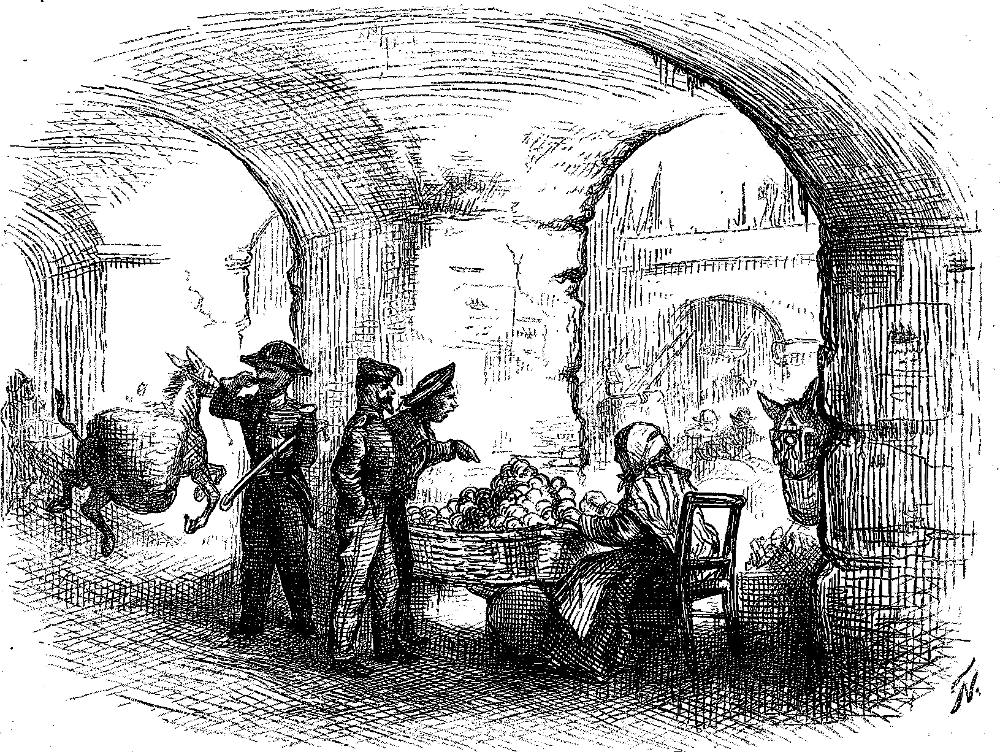
Near the Landing-Wharf by Thomas Nast, in Charles Dickens's Pictures from Italy, Sketches, and American Notes, fifth chapter, "Genoa and its Neighborhood," 24. Wood-engraving, 4 by 5 ¼ inches (10 cm high by 13.4 cm wide), vignetted.
Passage Illustrated: Dickens Arrives at Albaro
One of the rottenest-looking parts of the town, I think, is down by the landing-wharf: though it may be, that its being associated with a great deal of rottenness on the evening of our arrival, has stamped it deeper in my mind. Here, again, the houses are very high, and are of an infinite variety of deformed shapes, and have (as most of the houses have) something hanging out of a great many windows, and wafting its frowsy fragrance on the breeze. Sometimes, it is a curtain; sometimes, it is a carpet; sometimes, it is a bed; sometimes, a whole line-full of clothes; but there is almost always something. Before the basement of these houses, is an arcade over the pavement: very massive, dark, and low, like an old crypt. The stone, or plaster, of which it is made, has turned quite black; and against every one of these black piles, all sorts of filth and garbage seem to accumulate spontaneously. Beneath some of the arches, the sellers of macaroni and polenta establish their stalls, which are by no means inviting. The offal of a fish-market, near at hand — that is to say, of a back lane, where people sit upon the ground and on various old bulk-heads and sheds, and sell fish when they have any to dispose of — and of a vegetable market, constructed on the same principle — are contributed to the decoration of this quarter; and as all the mercantile business is transacted here, and it is crowded all day, it has a very decided flavour about it. The Porto Franco, or Free Port (where goods brought in from foreign countries pay no duty until they are sold and taken out, as in a bonded warehouse in England), is down here also; and two portentous officials, in cocked hats, stand at the gate to search you if they choose, and to keep out Monks and Ladies. For, Sanctity as well as Beauty has been known to yield to the temptation of smuggling, and in the same way: that is to say, by concealing the smuggled property beneath the loose folds of its dress. So Sanctity and Beauty may, by no means, enter. ["Genoa and Is Neighborhood," 24-25]
Relevant Marcus Stone illustrations for Pictures from Italy
Related Material
- Samuel Palmer — Pictures from Italy
- Gordon Thomson — Playing at Mora
- Charles Dickens, the traveler — places he visited
- Genoa and its Neighbourhood
- Charles Dickens's Tours of Italy
- Dickens and Family at the Villa di Bella Vista (The Bagnerello), Albaro: July-September, 1844
- Charles Dickens, 1843 daguerrotype by Unbek in America; the earliest known photographic portrait of the author
Scanned image, colour correction, sizing, caption, and commentary by Philip V. Allingham. [You may use this image without prior permission for any scholarly or educational purpose, as long as you (1) credit the person who scanned the image, and (2) link your document to this URL in a web document or cite the Victorian Web in a print one.] Click on the image to enlarge it.
Bibliography
Dickens, Charles. Chapter 4, "Genoa and its Neighborhood." Pictures from Italy, Sketches by Boz, and American Notes. Illustrated by A. B. Frost and Thomas Nast. The Household Edition. New York: Harper and Brothers, 1877. 19-32.
Dickens, Charles. Pictures from Italy and American Notes. Illustrated by A. B. Frost and Gordon Thomson. London: Chapman and Hall, 1880. 1-381.
Created 7 May 2019
Last modified 7 June 2020